Panasonic Lumix DC-GX9 Review
Panasonic Lumix DC-GX9 Introduction
The Panasonic Lumix DC-GX9 is the newest generation of what is now the intermediate-level series of Panasonic mirrorless. Although its predecessor entered the market as their Micro Four-Thirds flagship, the 9-level reshuffled the lineup with the G9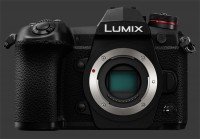
Panasonic Lumix G9 taking the flagship position wiith its large rugged body, the G95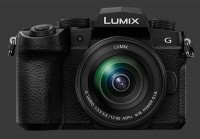
Panasonic Lumix G95 pushing towards the high-end with a mid-size weatherproof build and the GX9 becoming the rangefinder-style model. A GX850 reviewed here
Panasonic Lumix GX850 entry-level model without a viewfinder and fewer controls has yet be upgraded.
A 20 MP Four-Thirds CMOS sensor is shared between current generation Panasonic mirrorless cameras. This sensor is paired with a Venus Engine process that can process images at 9 FPS and uses a 240Hz sensor readout to peform Contrast-Detect AF using Panasonic's unique Depth-From-Defocus technology. This makes it possible to autofocus down to -4 EV. A 5-axis image-stabilization system built into the GX9 compensates for up to 4-stops of shake. The sensor and process together allow 4K video capture at 30 FPS and enabled many functions built around 4K.
With a rangefinder-style body, the GX9 is quite compact with a design that is highly suitable for street shooting due to its top-corner mounted tilting EVF, tilting LCD and dual control-dials. The 0.39" EVF is very sharp with 2.8 MP of resolution and shows 100% coverage at a large 0.7X magnification. It can tilt upwards 90° and includes an Eye-Start Sensor. There is a traditional mode-dial and a number of customizable controls at the back of the Panasonic Lumx DC-GX9.
This mirrorless is packed with plenty of features for its size. These includes 7-frame AEB, builtin HDR, Interval Timer, Time-Lapse, Focus-Stacking and more. Both WiFi and Bluetooth 4.2 LE allow the GX9 to transfer photos and be controlled remotely.
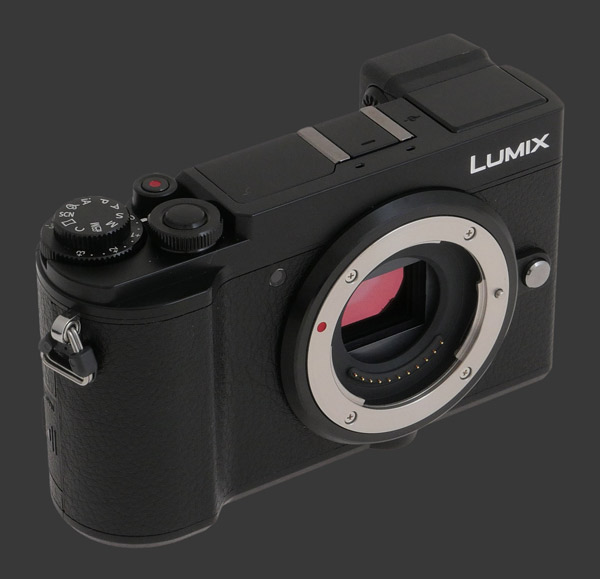
This digital camera review analyses the usability, image quality and performance of the Panasonic Lumix DC-GX9.
Panasonic Lumix DC-GX9 Features
Sensor
- 20 Megapixels CMOS Four-Thirds sensor
- 2X Crop-Factor, 4:3 Aspect-Ratio
- Sensor-Shift image-stabilization:
- 5-Axis
- 4-Stops
- Dua IS Compatible
- Micro Four-Thirds lens mount
- Ultra-sonic dust-reduction
Exposure
- ISO 200 - 25600 Standard sensitivity range
- ISO 100 Expanded sensitivity
- Auto ISO, customizable 400 - 25600 limit
- Hybrid Shutter:
- 1/8000-60s Mechanical Shutter-Speed range
- 1/16000-1s Electronic Shutter-Speed range
- Bulb exposure, 30 minutes max
- PASM Exposure modes with Program-Shift
- Multi-Segment, Center-Weighed and Spot metering modes
- Exposure-Compensation, ±5, 1/3 EV increments
- AEB, 3 - 7 frames, 1/3 - 1 EV increments
- Aperture-Bracketing, 3 or 5 steps
Image Parameters
- Automatic, 5 presetsSunny, Cloudy, Shade, Tungsten, Flash, Kelvin and 4 Custom White-Balance settings
- White-balance Fine-Tuning, 19-steps along 2 axis
- WB Bracketing, 3 frames, 2 step sizes, 2 axis
- Adjustable Contrast, Sharpness, Noise-Reduction, Saturation, Shadow Tone and Highlight Tone, 11 steps each
- 7 Color and 3 B&W Photo Styles
- sRGB or Adobe RGB color spaces
- Optional Long-Shutter Noise-Reduction
- Optional Vignetting Compensation
- Optional Shading Compensation
- Optional Diffraction Compensation
Drive
- Continuous Drive, 9 FPS, max 100 JPEG images or 30 RAW files
- 4K Continuous Drive, 30 FPS, 30 Frames, optional pre-buffering
- Self-timer, 2s, 10s or 3 shots @ 10 seconds
- Optional Shutter-Delay, Off or 1-8 seconds
- Time-Lapse, 1-9999 frames, 1s to 100m interval, immediate or delayed start
- Stop Motion Animation, Manual or 1-60s interval
- Built-in Auto HDR:
- ±1-3 EV
- Optional Auto Align
- Multiple-Exposure:
- 2-3 Frames
- Optional Auto Gain
- Optional Overlay
- Sweeping Panorama Mode
Focus
- Single-Shot autofocus (AF-S), Continuous (AF-C), DMF or Manual-Focus (MF)
- Pinpoint, Single-Area, Multi-Area, 49-Area, Subject Tracking and Face(Eye)-Detect Contrast-Detect AF
- Optional Quick AF
- Optional Eye-Start AF
- Optional MF-Assist
- Optional Focus-Peaking, 2 levels, 5 colors
- Optional AF-Assist lamp
Display & Viewfinder
- Builtin 0.39" EVF:
- 2.8 Megapixels
- 0.7X Magnification
- 100% Coverage
- Eye-Start Sensor
- 90° Tilt
- 3" Touchscreen LCD:
- 1.2 Megapixels
- 100% Coverage
- Tiling, 85° up or 45° down
- Digital Level, 2-axis, calibratable
- Optional Live-View in Manual mode
- Optional Live-Histogram
- Optional Guideline Overlay, 3 types
- Optional Blinking Highlight
- Optional Zebra Pattern, 2 levels or customizable
- Adjustable Brightness, Contrast and Saturation, 13 steps each
- Adjustable Tint, 21 steps, red and blue axis
Output Processing
- 4:3 Native aspect ratio
- 3:2, 16:9 & 1:1 cropped aspect ratios
- 20, 10 and 5 Megapixels mode
- JPEG, RAW, RAW+JPEG capture
- 2 JPEG Compression qualities
- Optional Contrast Enhancement, 3 levels
- Optional Resolution Enhancement, 4 levels
Video
- 4K Ultra-HD @ 30 FPS
- 1080p Full-HD @ 60 FPS
- MPEG-4 or AVCHD codec
- Built-in stereo microphone
- Audio-input gain, 4 steps
- Audio-meters, 2 channels
- Optional Wind-Filter, 2 levels
Connectivity
- 4K Ultra-HD HDMI output
- USB 2.0 connectivity
- WiFi (802.11b/g/n)
- Bluetooth 4.2 LE
Misc
- Dual control-dials
- Traditional mode-dial
- Exposure-Compensation dial
- Combined AE-L/AF-L button
- 3 Customizable buttons
- Depth-of-Field Preview
- Builtin popup flash
- Standard hot-shoe
- Lithium-Ion battery
- Internal Charging
- SDXC memory
Panasonic Lumix DC-GX9 Usability - How easy is it to use?
Panasonic considerably revised the ergonomics of the GX9. The new rangefinder-style design is more streamlined with an overall rectangular shape yet rounded sides and a subtle hand-grip. This makes is noticeably more compact than its predecessor. It feels just as sturdy, although it lost the weatherproof construction of the Panasonic Lumix DMC-GX8
Panasonic Lumix DMC-GX8.
While the small grip keeps the camera compact, it also makes it difficult to hold securely. There are eyelets on either sides of the camera to use a standard neck-strap which is highly recommended to keep this camera safe. The placement of the grip-side eyelet though is not ideal and makes it slightly uncomfortable to reach the shutter-release which is flat on the top plate. Nearly every control is packed on the same side of the camera, so reaching most requires very little hand movement.
On the front, there is a Micro Four-Thirds lens mount which is a standard created by Panasonic and Olympus and joined a good number of other camera and lens manufacturers. A small round lens release is found on the outer-side of the camera body and a tiny LED optionally acts as AF-Assist lamp when needed.
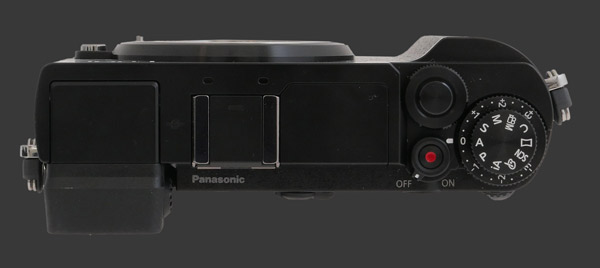
The top plate of the Panasonic Lumix DC-GX9 looks less busy than it is due to the mostly flat surface that spans over two thirds of the camera width. The tilting EVF modules occupies the left-most inch. Next to it, there is an industry-standard hot-shoe to use external lighting and, immediately adjacent, there is the top of the built-in popup flash. This tiny unit pops up forward in an attempt to clear the lens.
All top controls are tightly packed on the right side. A round two-stage shutter-release with short travel and a firm halfway point makes it efficient to take photos while minimizing accidental shots. It is surrounded by a textured front control-dial with good firm detents. The Video Record button is located behind it, elevated above a rotating power-switch. The recording button requires moderate travel and detents on the power-switch are very firm to avoid accidents. It is very good that Panasonic firmed up their controls which were easy to unintentionally change on previous models.
Both the dedicated Exposure-Compensation dial and traditional Mode-Dial are stacked against the rear-right edge of the camera. The lower one is a very large EC dial with firm detents. It is marked ±3 EV in 1/3 increments, the only exposure increments available on the GX9. Optionally, this dial can be ignored and EC can be dialed ±5 EVs using a control-dial instead. Above, the relatively small Mode-Dial manages to fit 10 positions: the typical PASM modes, plus a Movie mode, one Custom mode position, Sweep Panorama, one to group all Scene modes, one for all Special Effects modes and the Panasonic Intelligent Auto mode. The later continuously analyzes the scene in an attempt to optimize settings while locking the user out of most controls and consuming battery-power at an extra-ordinary rate.
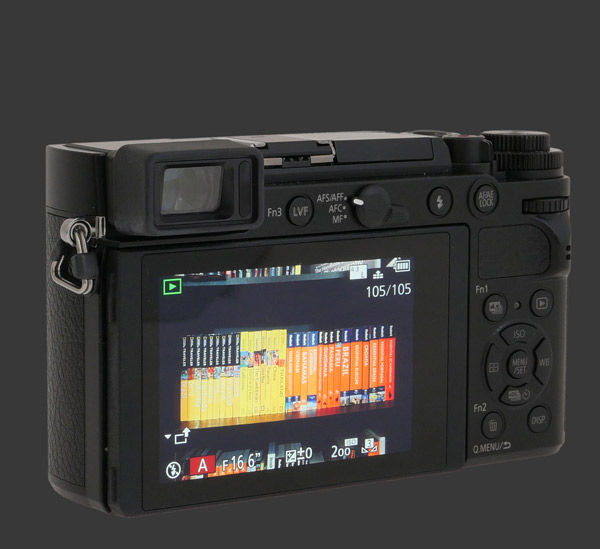
Everything else is packed on the back of the GX9 and it is quite busy there. Most of the space on the back is taken by the 3" LCD which is mounted on a double-hinge to tilt upwards 85° or downwards 45°. The screen itself very sharp with nice contrast and a good viewing angle. It is somewhat reflective in bright light but there is a very nice EVF with Eye-Start Sensor just above. The sensor can be set to high or low sensitivity. On High, it switches nearly instantly between the EVF and LCD.
At the top left corner, the 0.39" EVF protrudes from the back for extra comfort. This unit is plenty sharp with 2.8 megapixels, although the outer portion of the viewfinder are not normally used since Micro Four-Thirds has a native 4:3 aspect-ratio while the EVF itself is 16:9. The view through the viewfinder shows a large 0.7X magnification and 100% coverage. Color accuracy is very good in EVF, much better than on the LCD but the latter can be corrected. Panasonic again chose not to implement an Exposure-Priority preview which loses some of the advantages of having an EVF over an OVF. In Manual mode, exposure is simulated but not in other modes, although it is approximated. The EVF can be tilted upwards 90° which is very useful.
Right next of the EVF, there is a round button labelled LVF. The default function of this button is to cycle over the EVF, LCD or Automatic EVF/LCD switching. This button doubles as Fn3 which can be customized to one of 60 features. Most of these are shortcuts for settings in the menu but a few can only be activated via a customizable button, notable Depth-Of-Field Preview and Post-Shot Focus. More to the right, there is a 3-way switch to select between AF-S/AF-F, AF-C and MF modes. AF-F is uses as the first option instead of AF-S when the camera is set to iAuto mode.
Following along the top-edge of the LCD, the next button is the Flash Release button which is flush with the surface of the camera. The flash pops up immediately and must be manually pushed back down when no longer needed. To its right, there is a customizable AE-L/AF-L button. It offers AE-L, AF-L, AE+AF-L and AF-On modes. A separate menu option configures the button to be sticky or not.

Lined up directly below the stacked EC and Mode dials, there is a slim textured control-dial with firm detents. It has a good solid feel and can be pressed inwards to select settings. When controlling exposure parameters, the rear control-dial often duplicates the behavior of the front control-dial. In Manual mode though, one dial selects Aperture, the other selects Shutter-Speed. A Custom Menu option chooses which is which. Unfortunately, there is no way to override the duplicate dial to change ISO instead. A newly introduced feature adds modal operation which switches both dials to different settings, but one must remember to return back to normal.
The dual control-dials are put to good use otherwise:
- After invoking the Quick Menu, the front control-dial selects a setting, while the rear control-dial changes it.
- In Playback mode, the rear control-dial magnifies while the front one cycles between them while keeping the same magnification level. This is very useful to evaluate similar images for critical focus and detail.
- During menu navigation, the front control-dial changes tab and the rear one moves to the previous or next item. This is very logical and efficient.
- When viewing MF-Assist, the front one jumps by 0.1X magnification increments and the rear by 1X. Although this is easy to use during MF, it proves to be nearly impossible in DMF mode. There, the shutter-release must be held halfway down while turning the focusing ring and a control-dial simultaneously!
A small area below the AE-L/AF-L button and rear control-dial serves as thumb-rest. There really is not much space on the back of the GX9 because it features 4 more buttons plus a 4-way controller made of 4 additional separate buttons and an extra central one. The top left of these buttons is Fn1which is customizable to any of the same 60 functions as the previously described Fn3 button. It is a good idea to assign it to one of the otherwise unreachable functions such as Highlight Shadow, DOF Preview or Post-Shot Focus.
Towards the right, there is a typical Playback button which enters and exists Playback mode. The GX9 is shooting-priority, so a quick tap of the shutter-release automatically returns to Capture mode. Each direction of the controller is assigned a function:
- Up: Selects ISO. There are options from 200 to 25600, plus a low 100 when ISO Expansion is enabled and two Auto ISO settings.
- Right: Selects White-Balance. Any control-dial cycles over WB settings, including two Auto WB variants plus four Custom WB memories. Pressing down from there enters a WB Fine-Tuning and WB Bracketing screen.
- Down: Selects a drive mode: Off, Single-Shot, Continuous, 4K Burst, Bracketing and Self-Timer2s, 10s or 3-frames at 10s. There is no difference between Off and Single-Shot as far as we can tell.
- Left: Selects the AF mode: Pinpoint, Single-Area, Custom Area, Automatic 49-Area, Tracking and Face(Eye)-Detection. The focus point or area, depending on the mode, can be set by pressing Down fro there. Pinpoint allows the selection of an exact point while Single-Area allows the selection of an area in eight different sizes!
Two buttons remain below the 4-way controller. On the left, there is Fn2 which can also be set to one of 60 functions, which it invoking the Quick Menu by default. It Playback mode, this is the Delete button. When Instant Review is set to Hold, this button prompts for deletion. Otherwise, it jumps to the chosen Capture mode function.
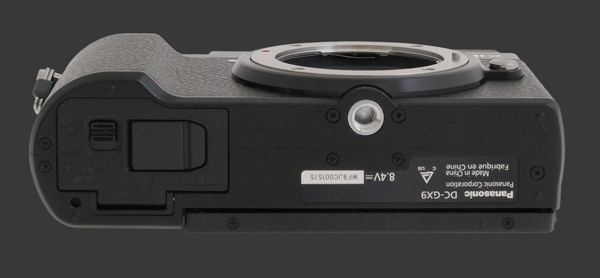
On the grip-side of the camera, there is an unusual spring-loaded door which covers the Micro HDMI and Micro USB ports. Given that the latter is used to charge the camera, it seems on the flimsy side. Panasonic does not provide a charger but they do sell a Travel Kit which includes a charger and battery. The bottom of the camera has a metal tripod mount directly inline with the optical center of the camera. This is ideal for panoramic photography. There is also a thin plastic door that covers the combined SDXC memory-card slot and battery compartment.
Overall ergonomics of the Panasonic Lumix DC-GX9 are reasonable. ISO is not settable directly by dial without switching modes which is unfortunate. The compact body necessarily means that controls numerous controls feel cramped yet most operations remain relatively efficient. The aspect that needs active monitoring is the misleading preview which does not always make it obvious when a scene will be overexposed. The camera itself feels quite solid and should last for a long time.
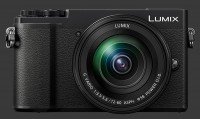 |
Please Support Neocamera
All information on Neocamera is provided free of charge yet running this website is a huge endeavor. Purchases made via affiliate links found throughout the site help keep it running and up-to-date. There is no additional cost to you, so please consider buying via these links to our affilates:
If you found any information on this site valuable and did not purchase via our affiliate links, please considering donating via PayPal:
Any amount will be greatly appreaciated. Thank you for your support!
Panasonic DC-GX9 Highlights

Sensor-Size: 17 x 13mm

Actual size when viewed at 100 DPI
| 20 Megapixels Mirrorless | ISO 100-25600 |
| Micro Four-Thirds Mount 2X FLM | Shutter 1/16000-60s |
| 5-Axis Built-in Stabilization, 4-Stop Improvement | Full manual controls, including Manual Focus |
| 0.39" Built-in EVF 2.8 Megapixels (0.70X) | Custom white-balance with 2 axis fine-tuning |
| Automatic Eye-Start sensor | Spot-Metering |
| 2 Axis Digital Level | Hot-Shoe |
| Built-in Dust Reduction | Lithium-Ion Battery |
| 9 FPS Drive, 100 Images | Secure Digital Extended Capacity |
| 3840x2160 @ 30 FPS Video Recording | |
| 3" LCD 1.2 Megapixels |
Updates
2025.01.18

Fujifilm GFX 2025 Lens Roundup
Lens Review roundup of Fujifilm GFX Medium-Format lenses. Quality, performance and handling of the GF20-35mm F/4R WR, GF30mm F/3.5 Tilt-Shift and the GF55mm F/1.7.
2024.11.18

Best 2024 Photography Gifts for Every Budget
Great gifts for photographers and photo enthusiasts selected for every budget among the best products of 2024.
2024.08.07

Eye Protection Tips for Professional Photographers
The four main considerations for professional photographers regarding eyewear.
2024.07.14

Fujifilm X100VI Review
Flagship fixed-lens compact digital camera with a 40 MP sensor and Image-Stabilization, a first for the series. Retro design featuring dual control-dials, plus direct ISO, Shutter-Speed and EC dials. Its hybrid viewfinder can switch between EVF and OVF mode.
2024.05.09

Fujifilm GFX100 II Review
Flagship 102 Megapixels Medium-Format Mirrorless Digital Camera with 8-Stop 5-Axis IBIS, 8 FPS Drive, 8K Video and 400 MP Super-Resolution capture in a weatherproof and freezeproof body with dual control-dials and dual memory-card slots.
2024.04.03

Fujifilm X-T5 Review
Newest Fujifilm flagship boasting a 40 MP APS-C sensor, 5-axis IBIS with 7-stop efficiency, 15 FPS continuous drive, 6.2K Video capture, dual control-dials and dual SDXC UHS-II slots in a sturdy weatherproof and freezeproof body.
2023.11.20

Best Digital Cameras of 2023
Find out which are the Best Digital Cameras of 2023. All the new Mirrorless Digital Cameras from entry-level to high-end professional.
2023.07.10

Fujifilm X-H2 Review
40 Megapixels APS-C Hybrid Mirrorless Digital Camera with 7-stop IBIS. Fastest shutter ever and 8K video capture. Large builtin EVF with 0.8X magnification and 5.8 MP, plus an Eye-Start Sensor. Packed with features and large number of controls in a weatherproof and freezeproof body.
2023.05.07

Sony FE 20-70mm F/4G Review
Review of the unique Sony FE 20-70mm F/4G lens. The optical zoom of this lens spans ultra-wide-angle and medium focal-length coverage, making it one of the most versatile Full-Frame lenses on the market.
2023.01.15

Huion Inspiroy Dial 2 Review
Review of the Huion Inspiroy Dial 2 tablet, a medium sized drawing surface with dual dials and customizable buttons. Connects via USB-C or Bluetooth 5.0 with Windows, Linux and Android support.
2022.12.08

How to Pack for a Photo Trip
Find out how to pack for a travel photography trip, carry your gear safely while meeting airline regulations.
2022.11.13

Best Digital Cameras of 2022
The best digital cameras of 2022. A short list of the most outstanding models in their respective categories. Choose one for yourself or as a gift.














